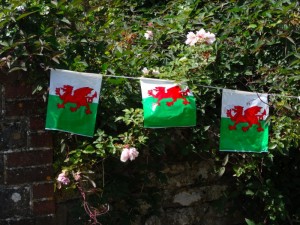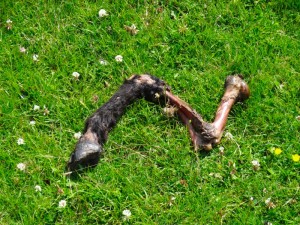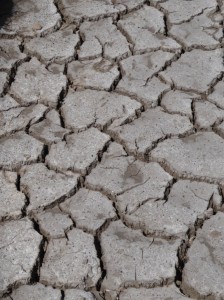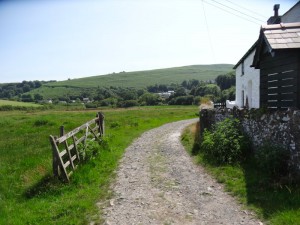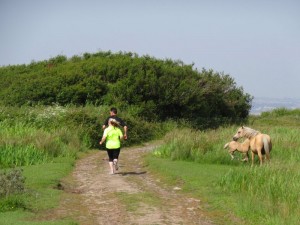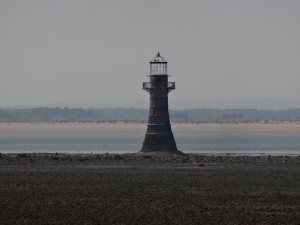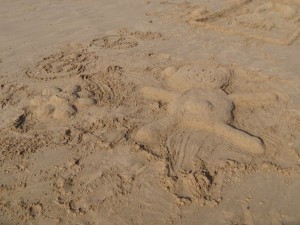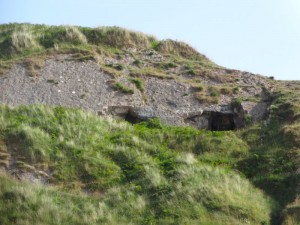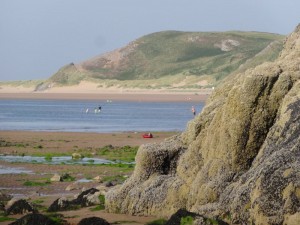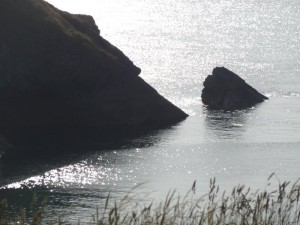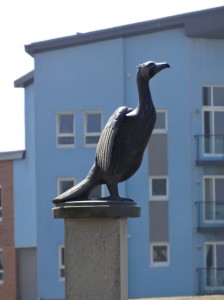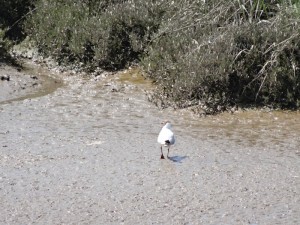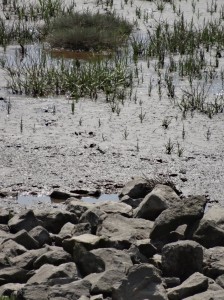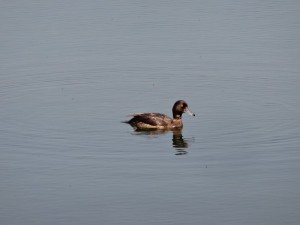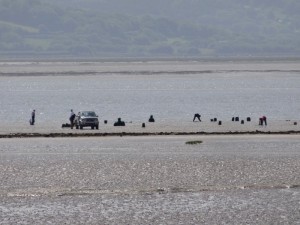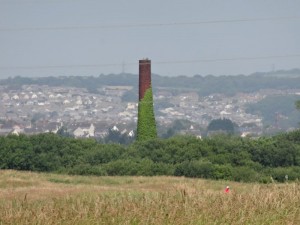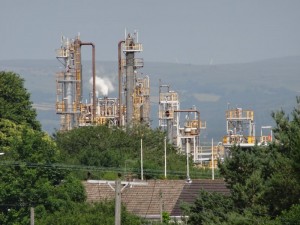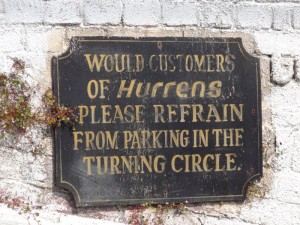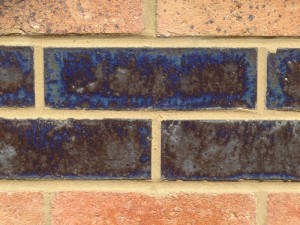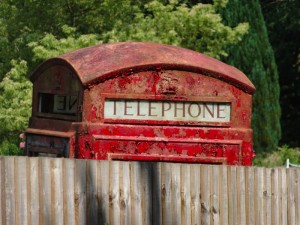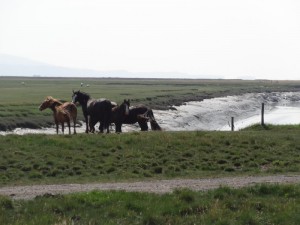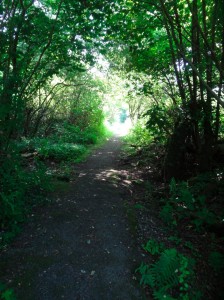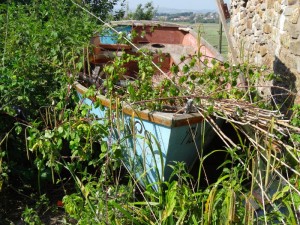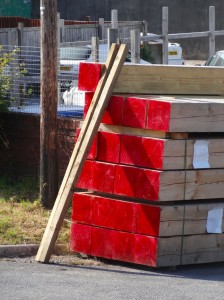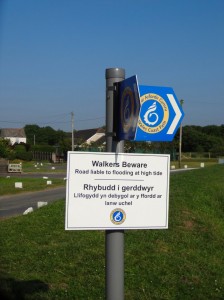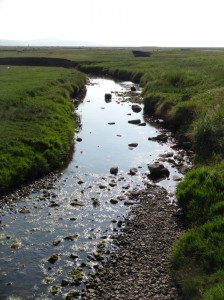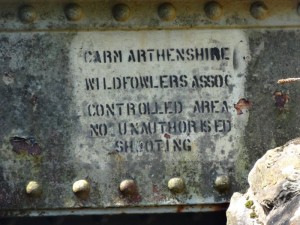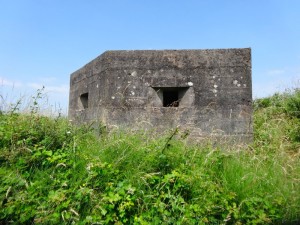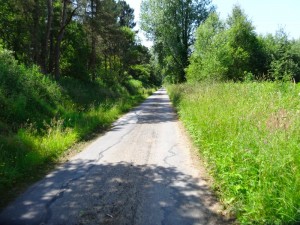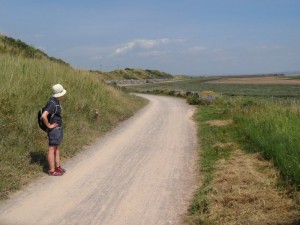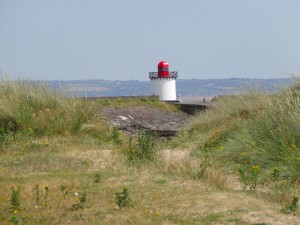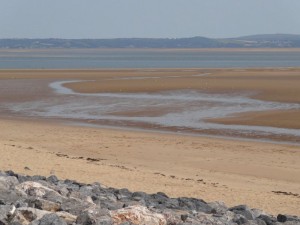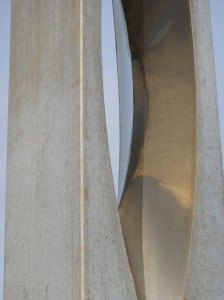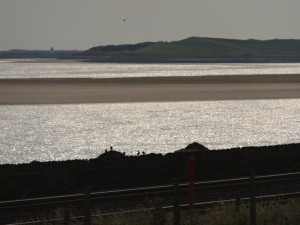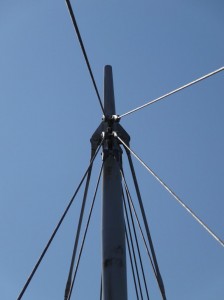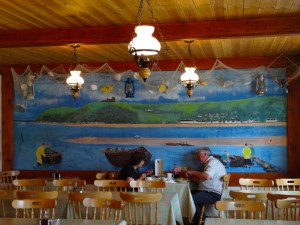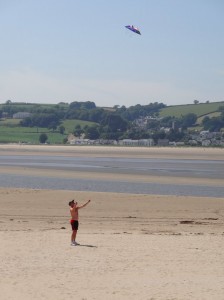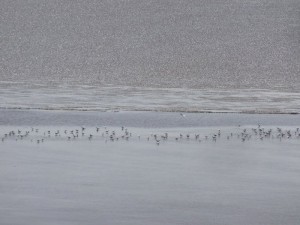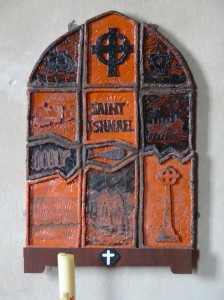meeting a new friend, and eating with old ones, tank tracks and snake tracks, the first female industrialist and the slow emancipation of women
16th July 2013
miles completed: 989
miles to go: 69
I have set myself a fixed agenda for the day in case anyone from Swansea can join me along the way, but set off a little late having stopped in the shop to book another day at Three Cliffs to be a writing and laundry day.
The path leads down past the upmarket shanty town of Notthill, down with snatched views through the gorse and bramble that line the path of the three rocky peaks of Three Cliffs Bay, which make it probably the most instantly memorable part of the entire Welsh coast, down along earthy track to the beach, stepping stones ahead to take you over the small Pennard Pill, that winds snake-like, hugging first this side, then the other side of the wide-mouthed bay.
A grass and gorse tipped, sandy, pebbly bar on the opposite bank forces the first, sharp, westward meander, almost at right angles to the sea, and separates the more grassy dune- and saltmarsh-filled valley to the north from the open sandy bay to the south. I had first seen this bay, coming down the path through the woods from scout camp at Parkmill, more than forty years ago. Coming across those grassy dunes we had unintentionally surprised a couple lying in one of the sandy hollows. We moved on, hurried by the look of intense annoyance on the man’s face, but the topic of just what and how much they had been doing in that sandy hollow was the subject of intense adolescent speculation in late-night tent conversations for the rest of the week.
On the far side of the stepping stones a large simple spiral labyrinth has been laid out on the small area of flat grass atop the bar. It reminds me of the slightly smaller, but more complex, labyrinth in North Wales, near Llanfairfechan. However, this one seems less permanent and I do not feel the same compelling desire to walk its winding path, and instead step carefully between its curving stone lines to cross it.
The path then follows the river back on itself eastward, the other side of the bar, and then cuts steeply up the dunes, feet sinking in moving sand as you climb, in some places step ladders of rope and wood laid loose upon the sand create makeshift steps, in others old wooden decking is visible, but lost amongst the marram grass. Construction amongst the shifting dunes is never a completed thing, like the Roman Steps out of Machynlleth. The ruins of Pennard Castle, high on the clifftop, only survive because they are where the underlying rock has eventually pushed through the sand.
At the high point, before Three Cliffs Bay drops out of view, there is a simple bench, placed there to enjoy either your last or first view of the bay. Except the sand has clearly eroded around it, so that the bench seat is at chest height, and to sit on it you need to clamber up and sit feet dangling, like a child, or Ronnie Corbett in his giant armchair; unless this is intentional, that you should feel child-like gazing with fresh eyes ever upon these landscapes all to easily reduced to postcard images.
It is not far to West Cliff, my first stopping point, where I hope to have breakfast at the café, and the signage on the beach at Three Cliffs is exemplary; however, I did something wrong at the tiny valley that leads down into Pobbles Beach, just beyond the ‘Three Cliffs’ of the bay. I was trying to follow the Coast Path strictly, as I thought that would be fastest (oh, when will I ever learn), so even though I could see a post across the little dry valley, barely 100 yards away, I followed the arrow pointing me up the valley, thinking they had a better place to cross it. Evidently there was, but I missed it and ended up going nearly half a mile skirting the golf course and almost to the clubhouse, and then another half a mile all the way back down again.
In the soft dune sand there are marks like tiny tank tracks; I imagine armies of uni-tracked vehicles doing military manoeuvres through the night. My less fanciful nature at first thought them snake tracks, largely I think because their zig-zag impressions reminded me of the adder’s back. Looking more closely at the better-marked ones, they are tiny overlapping prints, like a bird taking tiny steps, some with a tail mark between them, so maybe a lizard.
Despite the delay, it was only 10 or 15 minutes later than I intended when I drew into West Cliff at the edges of Southgate.
Many, many years ago, when I was, I think, fourteen or so, we spent a weekend with an old friend of Mum‘s, who had retired to Southgate. She and Mum had worked together in the Inland Revenue, until Mum got married. In those days women had to leave when they got married, which included losing all pension rights. Mum had worked in the Civil Service since her late teens, and left when she was 38, but Mary, with barely ten years’ more service, was able to take early retirement at 50. It is hard to believe nowadays with equality legislation, maternity leave, etc., although I do recall, even in the early 1980s, I was not allowed to take even one day’s unpaid leave to stay at the hospital with Fiona the day after Esther was born.
On that visit, a few years after the Parkmill scout camp, we had walked very much the paths I had today, across the golf course, dropping down into Three Cliffs Bay, taking the gap between the cliffs onto Pobbles Beach, and making a barbedue there. We used driftwood and cooked sausages that Mary had brought. I recall the best place to make the fire was in a nook in the rocks, but it had a small pool in front, so that I stood with feet in the water, making a waist-height fire, and carefully ferrying raw, then cooked sausages across to Mary, Mum and Jacqui sitting on the dry sand beneath the cliffs.
Behind them, in the cliffs, was a small blow-hole, and I recall partially climbing up it, but stopping when it got too narrow and I was scared of getting stuck. Some years later, I came here with my best friend Martin; I cannot recall how we got here, I guess train plus bus, and he, of course, ever the daredevil, pushed further up and I followed, but I do not recall if we ever managed to peek our heads through the top.
With Mary, Mum and Jacqui, we had then gone back up to the Golf Course, I think maybe the by the path up from Pobbles, probably joining the same clifftop route into West Cliff that I am walking this day. At one point, with the neat bungalows and houses of Southgate already visible over the open, grassy, cow-speckled clifftop ahead, four walkers appear striding, side by side, but spread out, every bit like the Magnificent Seven approaching to spread havoc in this most un-havoc-like area.
At West Cliff is the Three Cliffs café, naturally. It says that it is the first coffee shop in the Gower, established 15 years ago, and rebuilt twice as it has grown over the years. Of course, I was last here in the 1970s, a bit longer than 15 years. However, the shop was here then and I bought one of my first maps here, a purple tourist map of the Gower.
They still sell maps, and most importantly, also a full breakfast. The breakfast ingredients start with cockles wrapped in laverbread. I am not a great seafood person: I might have been tempted to try these at another time of day, but not breakfast. So, a bit wimpish, I ask for a breakfast without the signature item, the poor cook will have held up his hands in consternation; I’m surprised he did not come out, brûlée blow-torch in one hand, cleaver in the other, to remonstrate.
It reminds me of another holiday, this time in Paignton, when on a trip to Torquay, we went to a Golden Egg restaurant (a long vanished chain). I guess to make logistics easier with large numbers of people at breakfast, Mum cooked boiled, scrambled and poached eggs, but never fried. As today, still slightly wary of the culinary unknown, I ordered a ‘Golden Egg Special’, but without the egg.
I wait for the breakfast to arrive. It is a good food not a fast food café. I imagine the chef skipping down the cliffside to gather cockles and laverbread fresh for each breakfast, or in my case nip to a local farm to slaughter the pig for the susbstitute bacon.
Slowly drinking my tea, laptop before me, I hear a voice, "Are you Alan?"
I look up. I have got used to people addressing me by name having seen the banner on my rucksack, but there was something about the definitive nature of this that suggested more than a few moments’ familiarity.
It was Zetta, a friend of Parisa and Andrew Morgan, and fellow rambler. Indeed, she, like Andrew, had been involved in the early mapping out of the Coast Path in this area. She heard about the walk from Andrew and has been following the intermittent blog.
We talk about the walk and the gradually decaying feet. When she asks me about best bits, it turns out that she has also walked the Severn Bridge. However, in terms of simple scenery I say there is little that can compare with Three Cliffs. She agrees, and tells me how her sons, one in Malaysia, one in the US, when they come home to visit, as soon as they arrive want first to visit Three Cliffs Bay.
When the waiter arrives Zetta tells him I am famous, but, not having seen me on X-Factor, or the cover of Hello magazine, it is clear he is sceptical. As she leaves so that I can enjoy my cockle-free breakfast, she says that she hopes to join me in the walk at some point and clearly intends to text the news of the meeting at once to Andrew.
The path follows close to the road out of West Cliff past East Cliff and on to Slade, after which it once again follows the clifftop, sometimes wider, sometimes quite narrow between bracken and bramble, and at one point a sole sock hung forlornly, I guess tied to dry on the back of a rucksack. I was told by an experienced walker, "carry three pairs of socks, two on your feet and one to dry." One walker now has two and half pairs.
At Pwll Du Bay, the Bishopston Valley cuts many miles inland, so the path has to drop down to the beach and back up the far side. The route drops down initially between the fields, and later bare cliffside, but with a narrow ribbon of woodland virtually hiding them from the path that is itself sliced deeply into the soil. How many years of feet treading this same route will it have taken to wear down the earth to, now, shoulder height below the surrounding land? Beside the deep path birches rise at intervals, like flowering cherries in a suburban street, or an honour guard at a wedding, swarth swords held overhead.
It is a magical place, full of unfamiliar birdsong.
I fear my imagination has run away with me as every so often the birdsong and slight breeze breathing through the branches seem to form into motifs and melody. Surely I hear the humming of a few bars, distant, snatched notes.
Then, round the bend ahead, I spot a flash of colour. The murmured melody is a humming voice. I half expect to find a herb gatherer, healer, wise woman, singing out the goodness of plants as she stoops beside the path, but instead a young woman comes into view dragging a buggy up the path, which in its steepest point has been laid with stone steps.
I offer to help, but she says she is over the worst, and is clearly familiar with the path. When I mention the hints of music through the trees, she says she has been trying to pacify her little boy, who does not like the bumps over the steps. I offer my help again, but she explains that an unfamiliar face lifting up the wheels in front of her baby would probably not be wise. Anyway, today she is feeling better, having recovered from a marathon on Sunday.
Young mums perforce become athletes of sorts, hoisting toddlers onto shoulders, holding babies in one arm whilst doing all the tasks that normally take two hands with one, or, as in this case, hauling buggies up and down a world made for two feet not three wheels. I have spotted few parts of the path that I would term wheelchair or even buggy friendly. And this would not have reached my list.
I am impressed.
I tell her about Arry‘s epic run, and we talk for a few minutes about running and walking and bodies recovering. Some of the other runners in Tenby on Sunday had been in a bad way, she said, after the marathon, especially those who had not drunk sufficiently. I think about the soldier who had just died after training in the Beacons, it appears through heatstroke.
After warning me not to touch the poisonous Monkshood flowers that I may see at the bottom of the slope, she resumes her step-by-step bumping up the slope and I head down to the horse ford and footbridge below.
On the far side of Pwll Du, another pebble-barred bay, the route up follows quite a wide lane, which seems particularly rocky below, but in a way that makes me think it has been, in the past, well cut, maybe a crucial roadway in days long gone by.
After a while the old track cuts inland, and I am following again a plain grassed or earthy cliff path. Ahead of me I catch a movement on the track and stop. It is an adder. It too has spotted me and quickly winds its way into the grass beside the path. I look at its track: it is smooth, with just a sinuous impression like the levees of an aged river, nothing like the tiny tank-tracks I had spotted earlier in the day.
The cliffscape here has an almost Mediterranean air, with arid limestone, rocky hillsides covered patchily with sun-browned grass and the odd scrubby bush, and clear, clear blue seas. In a small, rocky cove, swimmers move leisurely through the clear waters.
Even the first glimpses of Caswell Bay have a Mediterranean appearance, a body-spread seashore, with some sort of beach café set right on the foreshore. It is just like Italy, where nature is always something to be controlled, subjugated and manufactured.
But despite its initial appearance, Caswell Bay is more a microcosm of society as a whole.
On the sands and in the beach takeaways are the plebeian hosts: beach-towel-draped corpulent bodies, young lanky men trying to look cool and soak up enough sun to camouflage their bony, white, freckled torsos, young women oiling themselves and adjusting bikinis to catch every ray of flowing sunshine, and several large groups of mums with toddlers, some in the sea corralling their offspring in the shallows, like cowboys on the range, and others on the beach standing guard around scatterings of sand-grubbing fingers, holding bright plastic spades as if they were sentries, although whether they are keeping the small feet from wandering out of an invisible compound, or keeping others from wandering in, is unclear.
Then above the sands rise apartments, piled, a thin flat structure, like the United Nations Building in New York, almost like the bikini-adjusting women, catching every sea-viewed ray of light. Homes for the retired, second homes for the affluent middle classes, a few hundred thousand for your jigsaw piece of postcard view.
And finally, scattered up the hillside beyond, expansive houses with spreading tree-filled gardens, the homes of the wealthy.
I settle for the beach café, a pot of tea and a Welsh cake.
Walking out from Caswell I overhear a snatch of a woman’s conversation on a phone, "I’ve got some issues with our Yurt, so can’t …"
Around the next headland Langland feels more like a seaside from a slightly different time, lined with cloned turquoise-green beach huts and busy, but somehow less crowded feeling than Caswell Bay.
The mix of people is not so different from Caswell Bay, and in general, although the elderly or younger retired are not absent, especially sitting outside the beach huts, the demographic is definitely younger than further round the coast. I’m not sure whether this is simply because it is now closer to full holiday season, or because of the proximity of a large city and the population of university students whose terms have ended, and simply the young people with days off or (most likely in these times) no job have gravitated to the sea.
I buy a hot dog and fizzy drink, soaking in the full seaside experience, and continue round the last mile of cliff path before Mumbles Head. I pass more people than on most parts of the Coast Path, but still it is relatively quiet and excepting the well-made-up, wheelchair-friendly path beneath my feet, it is amazing that this apparently quite wild cliffside is simply over the hill from the densely populated streets of Mumbles.
The first sign of civilisation is the large coastguard station, looking every bit like something from Tracy Island. There is a path that leads up towards it, but evidently does not skirt the headland, and is just for access. So I cross the large car park where a vintage double-decker bus sits stationary, its passengers relaxing in the open top, while an open tool chest suggests it may be a while before they complete their excursion.
I pass a Joe’s ice cream kiosk, in a giant apple. Why ice cream in a giant apple I don’t know, but it reminds me of Torchy, the little boy powered by a battery who used to travel to the town on the moon where the battered toys who had been abandoned by their owners lived out their lives in homes of hollowed out fruits. Only recently I learned, I wonder whether it was John Mariani who told me, that Torchy was in fact early Gerry Anderson, before Supercar, Fireball XL5, Stingray, and then the summit of his achievement, Thunderbirds – the Tracy Island connection again.
After the coastguard station is Mumbles Head proper and below it the pier and lifeboat station. I guess because of the lifeboat station, the pier is in good repair, unlike so many Victorian piers, and despite being at the far end of the prom, way away from the centre of Mumbles.
Just beyond Verdis, a popular wine-bar style coffee shop, a chalkboard on the quay advertises ‘The Pilot‘, a small pub across the road, facing the sea, which brews its own ‘Mumbles‘ beer as well as stocking other local beers and ciders. I tried the ‘Xperimentale‘, or ‘Lifesaver‘; as the name suggests, a new beer and very good. Although it is so close to the sea, it seems very quiet, almost as if it is hidden in plain view, but a real gem for real ale collectors.
However, the thing I had been told not to miss was Joe’s. I was told to ignore the Joe’s kiosks, although they too are good, but for the full Joe’s experience to head for the ice cream parlour on the high street opposite the prom. So I had skipped the Big Apple, and waited, and now I was there. It is a little beyond the crazy golf and a Methodist church that doubles as tourist information centre. At the parlour they make the ice cream and it is brought out in fresh churns every half hour to replenish the stock, so if you get it from the shop it has never been long-term frozen and has a more creamy texture.
Having been brought up on Thayers, it is hard for other ice creams to compete, but, for a vanilla ice cream, it was exceedingly good. As a measure of how good, I had bought a ‘99‘ with a chocolate flake sticking out, as I like chocolate with my ice cream (though not so much chocolate flavour ice cream), but once I had tasted the ice cream I ate the flake first so that I could enjoy the ice cream on its own.
Eating my cone I wandered on along the prom. There is a small sign about Amy Dillwyn, the ‘worlds first female industrialist’, who saved the ailing family zinc business at the end of the 19th century and lived out her days in Mumbles. Amongst other epitaphs, she is described as ‘author’, ‘water polo player’ (yes Steve), and ‘cigar smoker’. I wonder why I haven’t heard of her before, and think I would quite like to read what she has written.
Further along I pass two young men tightening one of those lorry load straps between trees, I assume to tight rope walk; a sad bunch of fading flowers tied to a sapling, maybe planted in remembrance, or maybe simply near the site of an accident; some strange metal sculptures; a tin can perched on a stick; and a gloriously multi-coloured graphic signpost.
After a long period walking on the prom, the sand looks easier to walk on so I cut down onto the long Swansea Beach. Talking to Zetta the next day, she told me that many people live in Swansea all their life and never venture onto this beach just a few streets from where they live. The part closer to Mumbles is more mud-like, but as you get closer to Swansea the sandy beach above the shingle and then mud line gets wider and wider, until, it is simply a broad beach running for several miles.
Although the main road runs just behind it, for much of its length there is a small dune that blocks the view and noise of the cars. I am amazed it is not more busy and that Swansea has never developed as an actual seaside town. Maybe it is the sight of Port Talbot‘s smoking towers far across the bay, or maybe because Swansea Port and industry used to mean the beach was less clean than it is today.
I pass the University, but it is getting later in the day, so I decide not to pop in ‘on spec’, but press on past the railway-bridge-like supports either side of the road that look as if they were once simply a very substantial pedestrian bridge. Past the clock tower above the concrete library, and then past the squat, grey, square-edged, stub-legged-star-fish-shaped, 1970s, modernist civic centre, with the towering, slender, oval-edged, nautical, glass and steel, modern apartment building beyond. The last is the megalithic entry marker for the dockside residential developments beyond, which fill a large triangle of space between old town and dockside, but seem devoid of any coffee house, corner shop, or newsagent, indeed anything that stands any chance of turning this housing complex into a community.
Although devoid of shops, this development does seem replete with all sorts of sculptures, including what looks as if it could have been an old water fountain, but now has incised stone panels with definitions of ‘net’, and opposite this, a brick tower called ‘The Tower of the Ecliptic‘. I have been trying to work out if the latter is a play on words, or simply a typo for ‘elliptic’.
You cross the Tawe over the Trafalgar Bridge, a pedestrian and cycle bridge over the weir and lock that separates the water-filled marina and old docks from the tidal river below. The part of the bridge over the lock can swing to let larger boats through, and a small boat is waiting in the lock, perhaps they do not bother to fill it until there is a critical mass. On the far side, past a boatyard and with views of the working dock, you approach the Prince of Wales Dock (maybe Edward VII rather than Charles), which has become a pleasure lake, with children leaping into the waters in various stages of undress, and waterside bars and restaurants.
That evening I shared a barbecue with Harold and Prue. Prue had worked at Laugharne on a community arts project and Harold is responsible for the talking prisoner there. In addition another old friend, Michael Harrison, came as he was in town for a meeting. We talked family and I caught up with some news, including the appalling oil train crash in Canada, but also human issues in the safety of medical devices, as Harold, Michael, and Chris, another guest at the barbecue, are all part of the CHIMED project.
When Harold drove me back to the campsite, we sat for so long chatting in the car, Prue will have been wondering how he could take so long to drive a short distance, or on second thoughts she knows Harold, and she knows me, so she will have probably guessed.

